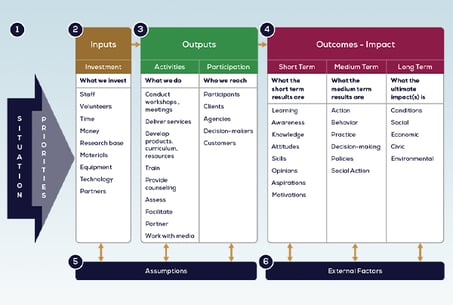How to Use A Logic Model to Supercharge Your Fatherhood Outcomes
3 min read
Date Published: 07/19/2022
Last Updated: 07/19/2022
National Fatherhood Initiative Blog / Latest Articles
3 min read


Can you articulate how your organization influences dads to improve their fathering skills?
If not, then a logic model is what you need.
A logic model maps the specific resources and activities necessary to produce the desired changes in the dads you serve, their families, and your community. It is not only a helpful tool to guide your decisions but also a great way to describe and justify your fatherhood work to staff, board members, and funders.
Now that you know a logic model is helpful for your fatherhood work, how do you create one? (Don’t worry, it’s not as daunting as you might think.)
A logic model shows what you want dads to gain from your program. It includes what is needed to reach program goals. Here are some basic parts of a simple and useful logic model:
Here is a great visual example of a logic model.
So, what’s the best way to apply this knowledge?
I recommend putting a team together (e.g., staff, board members, and volunteers) to brainstorm what to include in each part of the logic model.
If you already have a fatherhood program or initiative, then enter your current inputs, outputs, and outcomes, then assess whether you are missing anything or need to rethink any elements.
If you don’t currently have a fatherhood program or initiative, then consider the outcomes you want to see as a result and plug in the inputs and outputs your team thinks would create the best chance of success. For example, you may have to designate a staff person to oversee your work with dads, select a fatherhood curriculum, or design an evaluation process.
Here are a few examples of resources and technical assistance from National Fatherhood Initiative® (NFI) that can supercharge your logic model:
A logic model is a fantastic tool that can help turn your organization’s vision into reality. It will ensure you have a process to plan, carry out, and measure the success of your team’s efforts. When the well-being of children and families is at stake, it is well worth the investment.
If you currently have a logic model for your fatherhood work, is it time to revisit the inputs, outputs, and outcomes to explore updates and improvements?
If you don’t currently have a logic model for your fatherhood work, determine who should be on your team to create one and schedule the first planning meeting.
Date Published: 07/19/2022
Last Updated: 07/19/2022
Download the ebook to learn how to create fatherhood initiatives that engage every sector of community life.

Train Your Staff
Fatherhood Programs
Fatherhood Data
© 2025 National Fatherhood Initiative®. All rights reserved.